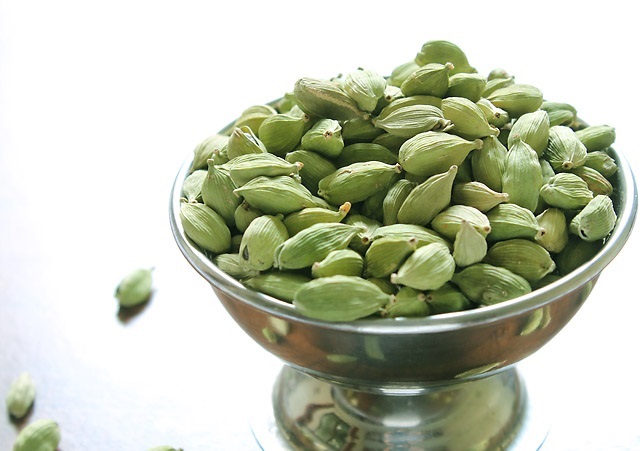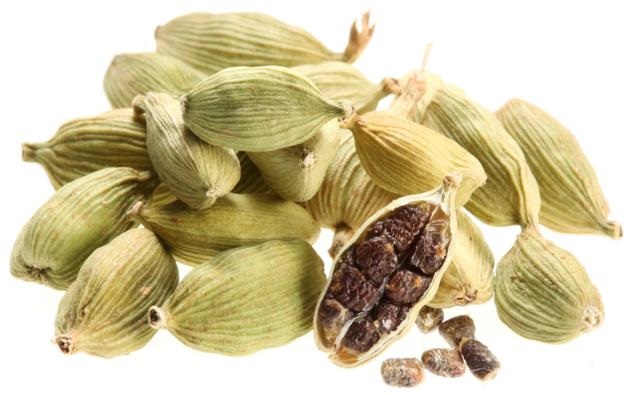Main Name: Cardamom
Biological Name: Elettaria cardamomum
Names in other languages: Cardamomo (Spanish), Cardamome (French), Chhoti ilaichi, Elaichi, Hari ilaichi (Hindi), Yelakkai, Elakkai (Tamil), Elathari (Malayalam), Yealak kayulu, Elakkayi (Telugu), Elaychi (Gujarati), Choto elach (Bengali), Velchil, Veldoda (Marathi), Alaichi (Oriya), Hari ilaichi, Elaichi, (Punjabi), Elaichi, Choti alaichi (Urdu)
Biological Name: Elettaria cardamomum
Names in other languages: Cardamomo (Spanish), Cardamome (French), Chhoti ilaichi, Elaichi, Hari ilaichi (Hindi), Yelakkai, Elakkai (Tamil), Elathari (Malayalam), Yealak kayulu, Elakkayi (Telugu), Elaychi (Gujarati), Choto elach (Bengali), Velchil, Veldoda (Marathi), Alaichi (Oriya), Hari ilaichi, Elaichi, (Punjabi), Elaichi, Choti alaichi (Urdu)
The aromatic fragrance it exudes is sufficient to induce any individual and drag him towards the gorgeous and mouth-watering delicacies prepared with it. This ‘Queen of Spices’ is the second largest consumed spice in the world, trailing behind black pepper, and world’s second most expensive spice, second only to saffron. Grind the seeds into powder, or use whole pods; cardamom adds the right and much-needed flavor to any delicacy, particularly when cracked a little just before being tossed in the preparations. Highly valued for its pleasant aroma, slightly pungent taste, and warm sensation; cardamom is native to India, the Middle East and North Africa. Referred by the names ‘Grains of Paradise’, ela, elachi, and elaichi amongst several others, cardamom is a versatile spice that adds an equally delicious and aromatic flavor to both pungent and sweet dishes. Cardamom, botanically known as Elettaria cardamomum, hails from the family of Zingiberaceae, or ginger. Three types of cardamom are found – green cardamom, brown cardamom and Madagascar cardamom. Cardamom isn’t just tasty, it’s healthy, too. With several essential nutrients and natural minerals present in cardamom, the health benefits and medicinal qualities are numerous. Improve the taste of your meal by adding this lovely spice and glance through the following sections to discover the health benefits cardamom has to offer. Your sure to shoot up your craving for this soothing and wholesome spice.
History
The origin of cardamom can be traced back to as early as 4th century BC in the monsoon forests of the Western Ghats in southern India. Today, this area is known as the Cardamom Hills, and until 200 years back, this area produced most of the world’s cardamom. The cardamom fruits have been in trade in India for more than 1000 years. They had been in print in the medical compendium Charaka Samhita between 2nd century BC and 2nd century AD. What’s more, it is also mentioned in the Sanskrit texts, Taitirriya Samhita of the 4th century BC. During the same time, the Greeks began importing cardamom from the East. While the inferior grades were called amomon, the superior grades were named kardamomon. Eventually, the Romans started importing substantial quantities of cardamom from India and regarded them as one of the most popular oriental spices in the Roman cuisine. Most of the cardamom was supplied from the evergreen monsoon forests of southern India and Sri Lanka. In 1903, cardamom plantation was abolished due to excessive production in Ceylon, now Sri Lanka, which led to low prices. The British colonies spread the plantation of cardamom in other parts of India as a secondary crop. Today, cardamom is largely used as an aromatic spice in Eastern, Arab and some Scandinavian cuisines.

http://www.flavorsofmumbai.com/green-cardamom-pods/
Health Benefits of Cardamom
- The high concentration of lenoleic acid improves blood circulation in the lungs by the blood thinning action; hence cardamom is beneficial for relieving the symptoms of asthma and bronchitis.
- Oral administration of cardamom seeds is known for inhibiting the growth of cancer cells, with rare cases of completely destroying the cells.
- Regular consumption of cardamom treats high cholesterol levels and reduces high blood pressure; thus, lowering the risk of cardiovascular diseases.
- Sexual dysfunctions, like impotency and premature ejaculation, are successfully treated with cardamom, particularly when consumed with milk and honey.
- Due to its natural anti-bacterial property, cardamom helps in neutralizing dental bacteria, thereby fighting bad breath and other oral health issues.
- An infusion of cardamom and cinnamon is used for curing pharyngitis, sore throat, uvula relaxation and hoarseness during the infective stage of influenza.
- Cardamom has been highly effective in treating gastrointestinal problems, like indigestion, nausea, vomiting, stomach pain, constipation, upset stomachs and flatulence.
- Due to its anti-spasmodic properties, cardamom helps in preventing spasms and convulsions.
- Inflamed nerves and backaches have been known to be successfully treated with the application of cardamom oil or consuming cardamom seeds.
- Cardamom boosts appetite in anorexic patients, a disorder characterized by excessive weight loss. Consuming cardamom increases hunger pangs, thereby helping in the recovery process.
- Cardamom stimulates the natural process of detoxification through sweating and urination, thereby purifying the entire body and strengthening the kidneys and urinary system.
- By reducing the air and water elements, cardamom relieves stomach dyspepsia, cures indigestion and soothes the mucus membrane. As such, the gas and heartburn caused by garlic and onion is effectively relieved by cardamom.
- Cardamom, when mixed with banana leaf powder and amla juice, is an excellent diuretic for treating gonorrhea (inflammation of the urethra or vagina), cystitis (inflammation of the urinary bladder), nephritis (inflammation of the kidneys) and burning or infrequent urination.
- Cardamom, when added to tea, gives a pleasant aroma, which serves as an effective remedy for depression.
- It has stimulating effects that secretes various enzymes and hormones, gastric juices, peristaltic motion, circulation and excretion; thereby maintaining proper metabolism.
- When combined with honey and other spices, cardamom acts as an effective cure for laryngitis and tuberculosis.
- Cardamom acts as a natural health tonic, when taken at bedtime, diluted with milk and honey. Besides, it is effective in preventing memory loss.
Cardamom Nutrition FactsAmount: 100 g
Total Weight: 100 g
Total Weight: 100 g
| Nutrients | Amount |
| Basic Components | |
| Proteins | 11 g |
| Water | 8.3 g |
| Ash | 5.8 g |
| Phytosterols | 46 mg |
| Calories | |
| Total Calories | 311 |
| Calories From Carbohydrate | 219 |
| Calories From Fat | 56 |
| Calories From Protein | 36 |
| Carbohydrates | |
| Total Carbohydrates | 68 g |
| Dietary Fiber | 28 g |
| Fats & Fatty Acids | |
| Total Fat | 6.7 g |
| Saturated Fat | 680 mg |
| Monounsaturated Fat | 870 mg |
| Polyunsaturated Fat | 430 mg |
| Omega-3 Fatty Acids | 120 mg |
| Omega-6 Fatty Acids | 310 mg |
| Vitamins | |
| Vitamin C | 21 mg |
| Thiamin | 198 mcg |
| Riboflavin | 182 mcg |
| Niacin | 1.1 mg |
| Vitamin B6 | 230 mcg |
| Minerals | |
| Calcium | 383 mg |
| Iron | 14 mg |
| Magnesium | 229 mg |
| Phosphorus | 178 mg |
| Potassium | 1.1 g |
| Sodium | 18 mg |
| Zinc | 7.5 mg |
| Copper | 383 mcg |
| Manganese | 28 mg |

http://www.thehindubusinessline.com/portfolio/real-assets/cardamom-will-retain-its-flavour/article6367129.ece
How many calories in cardamom (per 100 gm)
Cardamom has about 311 calories per 100 gm of weight.
Cardamom has about 311 calories per 100 gm of weight.
How to Buy Cardamom
- Cardamom is available as whole pods and in powdered forms in the market all round the year.
- You can easily find both varieties of cardamom. ‘Elettaria’ pods are small and light green in color, while ‘Amomum’ pods are larger and dark brown.
- To check the freshness of the pods, scratch the pod with your fingertip. In case it gives off a sweet aroma, the pod has passed the test.
- Do not buy pods that are light in color and have stains, spots or molds.
Cardamom Storage Tips
- Always store cardamom pods in an airtight container in a cool, dark and dry place.
- When placed in the refrigerator, cardamom pods retain their freshness for longer durations.
- Powdered cardamom should always be kept in a tightly sealed container and should be used at the earliest as it tends to lose its flavor quickly.

